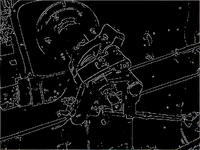
Photo from wikipedia
In interocular masking, a stimulus presented to one eye (the mask) is made stronger in order to suppress from awareness the target stimulus presented to the other eye. We investigated… Click to show full abstract
In interocular masking, a stimulus presented to one eye (the mask) is made stronger in order to suppress from awareness the target stimulus presented to the other eye. We investigated whether matching the features of the target and the mask would lead to more effective suppression (feature-selective suppression), or not (i.e., non-selective suppression). To control the temporal characteristics of the stimuli, we used a dynamic interocular mask to suppress a moving target, and found that neither matching speed nor pattern of motion led to more effective suppression. Instead, a faster target was detected faster, regardless of the mask type or speed, while a relatively slow (about 1°/s) mask was more perceptually stable (i.e., maintained suppression longer) in a non-selective fashion. While the requirement for target detectability, i.e., salience, is well characterized, relatively little attention is given to the factors that make a mask percept more perceptually stable. Based on these results, we argue that there are separate requirements for detection and perceptual stability.
Journal Title: Scientific Reports
Year Published: 2017
Link to full text (if available)
Share on Social Media: Sign Up to like & get
recommendations!